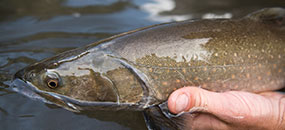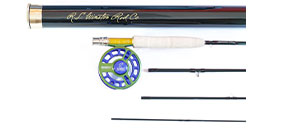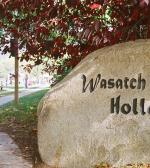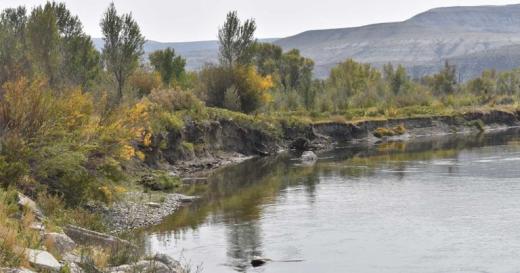Author: Olivia Kennah, SweetwaterNOW
GREEN RIVER — When a major snow and wind storm ravaged Green River on September 7 and 8, the city was left with an estimated $1 million in damages, including several of the city’s trees being blown over.
Though the impacts of the storm on the city have been devastating, Seedskadee Chapter #533 of Trout Unlimited found a way to capitalize on the storm’s aftermath, uncovering a silver lining.
Riverbank stabilization along the Green River has been a growing concern for years, and plans to use a log combo as a means for stabilization have been in the works for the past several years. However, finding the trees to use and transferring them to Green River was going to be a costly and time consuming task.
“The windstorm was really horrible. But because it happened we just kind of thought, let’s capitalize on it,” Walrath said.
Now instead of hauling trees from the Ashley National Forest in the Bridger Valley and around Kemmerer, the city’s own trees are being repurposed to supply riverbank stabilization in some of the areas the Green River needs it the most.
Walrath contracted Longhorn Construction to haul the trees from around town to FMC Park, and brought down WWC Engineering, based in Laramie, to scout the project, plan the design, figure out how to use the logs, and then provide estimated costs for construction.
Once all of that is done, Walrath will look to begin securing grants and funding.
- Nick Walrath and Justin Terfehr talk to one of the Longhorn Construction workers.

- Longhorn Construction works on removing a fallen tree from Veteran’s Park.
Cost Savings to the City of Green River
Green River Parks and Recreation Director Brad Raney said the partnership with Trout Unlimited to remove the trees has saved the City of Green River time and money.
Raney believes using Longhorn Construction has saved three to four weeks of cleanup time, and has allowed the city employees to go back to their regular responsibilities sooner such as mowing, athletic field prep, and park inspections.
Since Walrath handles payments to Longhorn Construction through grant monies Trout Unlimited has already obtained, any payments made equate direct savings to the City of Green River.
“The savings to the city and taxpayers is significant,” Raney said.
Though the storm caused a lot of damage, Raney pointed out that the partnership with Trout Unlimited has uncovered quite a few positives in the situation.
“This partnership is a win all the way around: it saves the city money and time, parks return normal sooner, it should reduce the overall cost of the project proposed by Trout Unlimited, the Riverbank project will benefit the city and users of FMC park, and a local contractor is completing the tree removal and hauling,” Raney said.
Longhorn Construction workers move a tree onto a truck to be hauled to the Scott’s Bottom area.
Eroding Riverbank
About two years ago, a study was done to see how much sediment was eroding from the Scott’s Bottom Green River riverbank on the on both sides of the FMC bridge. What Trout Unlimited discovered was that 1,600 tons of sediment from the riverbank was contributing to the system that goes to the Flaming Gorge- every year.
“That’s 100 dump truck loads worth of sediment,” Walrath said.
Walrath and Justin Terfehr, Professional Engineer with WWC Engineering, explained how much the riverbank has eroded in the past few years, giving an idea of how much worse the situation could get if left unaddressed.
The below photo shows where the river bank used to be, the island in the middle of the river, compared to where it is at now. That erosion took place over the course of just 10 years.

On the other side of the bridge, upstream, is further erosion. Walrath said there used to be two cottonwood trees a few feet from the river bank, and now those trees are in the river.

“If we left it, within the next few years the walk way there would be compromised or in the river,” Walrath said.
Fixing issues such as riverbank stabilization not only address the unwanted erosion of the banks, causing the river to widen, but it also helps to address blue algae blooms.
“Addressing these issues won’t stop the blooms, but it will help,” Walrath said.
By using root balls and logs in the river bank, in what is called a “toe wood structure”, the logs sit at the toe of the slope and the root ball sits at the edge of the water. The trunks are buried at the back of the bank, according to Terfehr.
The structure not only stabilizes the bank, but it also acts as good aquatic habitat.
“Two birds with one stone,” Terfehr said.
On the opposite side of the riverbank where the cottonwood trees used to be, it shows a healthy riverbank with vegetation.
“That’s what we want to emulate long term,” Terfehr said.

Moving Forward
Walrath said this project has been in the talks since 2015, and they have been serious about it since at least 2017. It has taken since then to be able to figure out how to move forward and generate the funds for the project.
“We are continuing to seek partners in this project. Large projects like this are a collaborative effort and take many different entities to complete,” Walrath said.
As of right now the partners that have committed funding or in-kind contributions for the Scott’s Bottom Project include U.S. Fish and Wildlife Services Partners Program, Wyoming Wildlife and Natural Resource Trust Fund, Wyoming Landscape Conservation Initiative, Wyoming Game and Fish Department Trust, City of Green River, Sweetwater Conservation District, and Wyoming Water Development.
Trout Unlimited is seeking additional donation to move forward with this project. For anyone interested in making monetary donations, contact Nick Walrath at nwalrath@tu.org.

Nick Walrath with his family. Photo credit: Hillary Walrath










